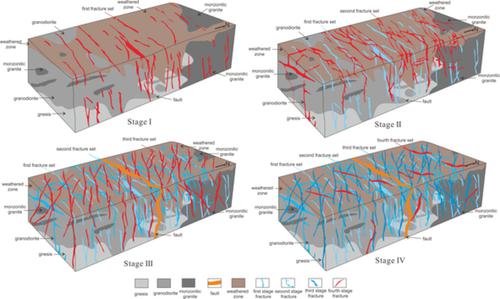当前位置:
X-MOL 学术
›
Geolog. J.
›
论文详情
Our official English website, www.x-mol.net, welcomes your
feedback! (Note: you will need to create a separate account there.)
Characteristics and formation mechanism of the fractures in Archaean buried hill: A case study in the BZ19‐6 Block, Bohai Bay Basin, China
Geological Journal ( IF 1.4 ) Pub Date : 2020-12-20 , DOI: 10.1002/gj.4052 Xiaojuan Dai 1, 2, 3 , Huafeng Tang 1, 2, 3 , Huiyong Li 4 , Yan Zhang 3 , Peng Xu 4 , Pujun Wang 3 , Guomin Song 3 , Xianli Du 5
Geological Journal ( IF 1.4 ) Pub Date : 2020-12-20 , DOI: 10.1002/gj.4052 Xiaojuan Dai 1, 2, 3 , Huafeng Tang 1, 2, 3 , Huiyong Li 4 , Yan Zhang 3 , Peng Xu 4 , Pujun Wang 3 , Guomin Song 3 , Xianli Du 5
Affiliation

|
While Archean buried hill fractured reservoirs have been found for the first time in the BZ19‐6 Block of the Bozhong Sag in the Bohai Bay Basin, the mechanisms driving their creation and evolution are not well known for low degree of exploration. Using core data, image logs, and our knowledge of the regional geology, we characterized the features and explored the formation mechanisms of these fractures. Our core samples captured two types of fractures: high‐angle shear fractures and low‐ to moderate‐angle tensile fractures. Based on the cross‐cutting relationships, four distinct sets of fractures formed at different stages and related to different tectonic events. The first fracture set (Set I) is high‐angle shear fractures having an E‐W orientation, partially filled by calcite, and was formed by transpressive processes in the Early Yanshanian. The second fracture set (Set II) is characterized by moderate angles, partially filled by asphalt and calcite with variable orientations and a more mesh‐like appearance, formed in an extensional environment in the middle Yanshanian. During transpressive activities in the Late Yanshanian, the high‐angle shear fractures of the third fracture set (Set III) formed with NW‐SE orientations and partially filled by asphalt. The fourth fracture set (Set IV), which occurred in the Early Himalayan, involves high‐angle shear fractures that is oriented in the NE‐SW direction and only part of them are filled by clay minerals. Macroscopic fracture features, orientations, and distribution patterns can significantly alter the nature of a reservoir; the fractures in Set I (E‐W‐oriented) and III (NW‐SE‐oriented) are typically the widest (excluded fills), and they tend to have the greatest impact on the overall reservoir permeability.
中文翻译:

古生界潜山的裂缝特征及形成机制-以渤海湾盆地BZ19-6区块为例
虽然在渤海湾盆地渤中凹陷BZ19-6区块首次发现了太古宙潜山裂缝性储层,但由于勘探程度低,导致其形成和演化的机制尚不为人所知。利用核心数据,图像测井资料以及我们对区域地质的了解,我们对特征进行了描述,并探讨了这些裂缝的形成机理。我们的核心样本捕获了两种类型的裂缝:高角度剪切裂缝和低至中角度拉伸裂缝。根据横向关系,在不同的阶段形成了四组不同的裂缝,并与不同的构造事件有关。第一个裂缝组(I组)是具有E-W方向的高角度剪切裂缝,部分由方解石填充,是由燕山期早期的超压过程形成的。第二个裂缝组(第二组)的特征是中等角度,在燕山中部的伸展环境中形成,沥青和方解石的方向不同,且具有更多的网状外观。在燕山晚期晚期的超压活动中,第三裂缝组(第三组)的高角度剪切裂缝以西北-东南方向形成,部分被沥青填充。第四组裂缝(第四组)发生在喜马拉雅山脉早期,涉及沿NE-SW方向定向的高角度剪切裂缝,其中只有一部分被粘土矿物填充。宏观裂缝特征,方向和分布模式会显着改变储层的性质。I组(EW方向)和III组(NWSE方向)的裂缝通常是最宽的(不包括填充),
更新日期:2020-12-20
中文翻译:

古生界潜山的裂缝特征及形成机制-以渤海湾盆地BZ19-6区块为例
虽然在渤海湾盆地渤中凹陷BZ19-6区块首次发现了太古宙潜山裂缝性储层,但由于勘探程度低,导致其形成和演化的机制尚不为人所知。利用核心数据,图像测井资料以及我们对区域地质的了解,我们对特征进行了描述,并探讨了这些裂缝的形成机理。我们的核心样本捕获了两种类型的裂缝:高角度剪切裂缝和低至中角度拉伸裂缝。根据横向关系,在不同的阶段形成了四组不同的裂缝,并与不同的构造事件有关。第一个裂缝组(I组)是具有E-W方向的高角度剪切裂缝,部分由方解石填充,是由燕山期早期的超压过程形成的。第二个裂缝组(第二组)的特征是中等角度,在燕山中部的伸展环境中形成,沥青和方解石的方向不同,且具有更多的网状外观。在燕山晚期晚期的超压活动中,第三裂缝组(第三组)的高角度剪切裂缝以西北-东南方向形成,部分被沥青填充。第四组裂缝(第四组)发生在喜马拉雅山脉早期,涉及沿NE-SW方向定向的高角度剪切裂缝,其中只有一部分被粘土矿物填充。宏观裂缝特征,方向和分布模式会显着改变储层的性质。I组(EW方向)和III组(NWSE方向)的裂缝通常是最宽的(不包括填充),











































 京公网安备 11010802027423号
京公网安备 11010802027423号